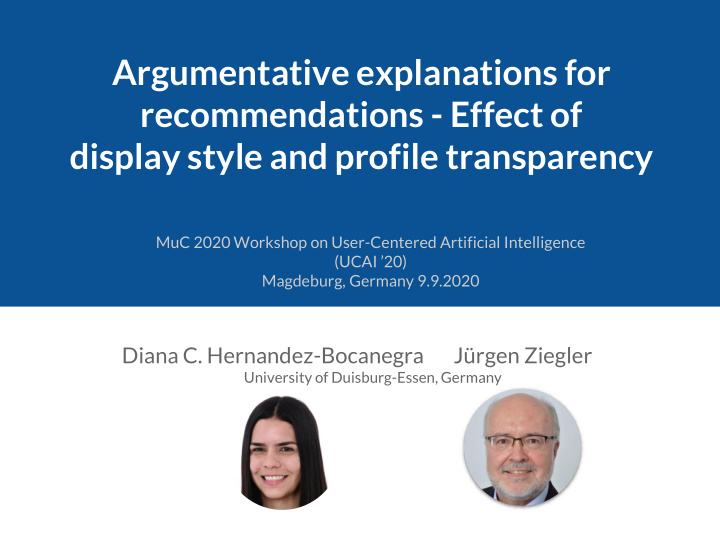



Argumentative explanations for recommendations - Effect of display style and profile transparency MuC 2020 Workshop on User-Centered Artificial Intelligence (UCAI ’20) Magdeburg, Germany 9.9.2020 Diana C. Hernandez-Bocanegra Jürgen Ziegler University of Duisburg-Essen, Germany
Motivation ▪ Transparency and effectiveness of RS may be increased when explanations are provided [Tintarev and Masthoff. 2012]. ▪ To go beyond this! or this ▪ Our proposal: an argument-based approach to generate verbal and graphic-based explanations. ▪ Our particular aim: To test the effect of different presentation styles on users’ perception.
Exploiting of online reviews in explainable RS ▪ Abstractive summaries of opinions using natural language generation (NLG) techniques [Costa et al. 2018]. ▪ Joint deep modeling of items and users from reviews [Zheng et al. 2017]. Use of attention mechanism to extract useful reviews [Chen et al. 2018]. ▪ A feature-based summarized view of pros and cons From: https://blog.ad7.io/ reported by customers, leveraging aspect-based sentiment detection, e.g. matrix factorization explanatory model by [Zhang et al. 2014]
Review-based explanations in RS Features “You might be interested in selected [feature], on which this product by performs well” relevance (Zhang et al. 2014) (Hernandez-Bocanegra et al. 2020) Features sorted by relevance (Wu and Ester 2016) (Muhammad et al. ’16)
User profile transparency in RS (Abdollahi and Nasraoui 2017) (Vig et al. 2009)
Explanatory RS method Explicit Factor Model (EFM), Zhang et al. 2014 Based on Matrix Factorization, incorporates user reviews. Aim: align latent and explicit features. n=8 (items) p=5 (explicit features) p=5 (explicit features) Optimization task: n=8 m=10 m=10 (items) (users) (users) Item quality matrix (Y) Rating Matrix (A) User preference Matrix (X) (how many positive / negative (how many times user talk comments about a feature) Explanation template: about a feature) “You might be interested in [feature], on which this product performs well”.
Explanation design proposal Explanation provided in user study (condition style ‘visual’, user preferences ‘yes’)
Explanation design proposal Explanation provided in user study (condition style ‘text’, user preferences ‘yes’)
Research questions In regard to quality of explanation, and the explanatory aims of transparency, effectiveness, efficiency and trust: ▪ RQ1: Does the display style of explanation (using charts or only text) influence the perception of the variables of interest? ▪ RQ2: Does including or not the information about user preferences influence the perception of the variables of interest? ▪ RQ3: Do individual differences in decision making styles , social awareness or visualization familiarity influence the perception of these variables when the proposed explanations are provided?
Empirical study 2x2 between-subjects design 2 Display styles, 2 user preferences display (yes, no) x 152 Perception assessment Variables: Explanation quality, transparency, effectiveness, (AMT workers) efficiency, trust Covariates User characteristics: Decision making style, social awareness, visualization familiarity
Empirical study Display style ‘visual’ Display style ‘text’ User preferences ‘yes’ User preferences ‘no’ Empirical study, experimental conditions
Empirical study: Results No main effects of the display of user preferences were found vs Transparency, User preferences ‘yes’ Transparency, User preferences ‘no’ (M=3.87, SD=0.71) (M=3.72, SD=0.79)
Empirical study: Results A significant interaction between social awareness and the display of user preferences was found (F(1, 146) = 4.79, p<.05).
Empirical study: Results No main effects of the display style or visualization familiarity were found vs
Empirical study: Results A possible interaction effect between rational-decision making style and display style on effectiveness (F(2, 146)=2.82, p=.09).
Empirical study: Results A main effect of social awareness was found on all our variables of interest
Limitations ● Use of a prototype, were users actual preferences could not be requested or detected. ● Use of AMT platform, where choices are hard to motivate.
Social awareness and rational decision-making style influence the perception of review-based RS, in regard to different display styles and profile transparency. Thank you for your attention!
Recommend
More recommend